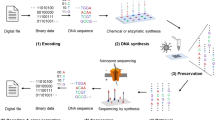Abstract
The origin of homochirality in living systems is often attributed to the generation of enantiomeric differences in a pool of chiral prebiotic molecules1,2, but none of the possible physiochemical processes considered1,2,3,4,5,6,7 can produce the significant imbalance required if homochiral biopolymers are to result from simple coupling of suitable precursor molecules. This implies a central role either for additional processes that can selectively amplify an initially minute enantiomeric difference in the starting material1,8,9,10,11,12, or for a nonenzymatic process by which biopolymers undergo chiroselective molecular replication13,14,15,16. Given that molecular self-replication and the capacity for selection are necessary conditions for the emergence of life, chiroselective replication of biopolymers seems a particularly attractive process for explaining homochirality in nature13,14,15,16. Here we report that a 32-residue peptide replicator, designed according to our earlier principles17,18,19,20, is capable of efficiently amplifying homochiral products from a racemic mixture of peptide fragments through a chiroselective autocatalytic cycle. The chiroselective amplification process discriminates between structures possessing even single stereochemical mutations within otherwise homochiral sequences. Moreover, the system exhibits a dynamic stereochemical ‘editing’ function; in contrast to the previously observed error correction20, it makes use of heterochiral sequences that arise through uncatalysed background reactions to catalyse the production of the homochiral product. These results support the idea that self-replicating polypeptides could have played a key role in the origin of homochirality on Earth.






Similar content being viewed by others
References
Bonner, W. A. The origin and amplification of biomolecular chirality. Origins Life Evol. Biosph. 21, 59–111 (1991).
Bada, J. L. Origins of homochirality. Nature 374, 594–595 (1995).
Bonner, W. A., Blair, N. E. & Dirbas, F. M. Experiments on the abiotic amplification of optical activity. Origins Life 11, 119–134 (1981).
Cronin, J. R. & Pizzarello, S. Enantiomeric excesses in meteoritic amino acids. Science 275, 951–955 (1997).
Kondepudi, D. K. & Nelson, G. W. Weak neutral currents and the origin of biomolecular chirality. Nature 314, 438–441 (1985).
Kondepudi, D. K., Kaufman, R. J. & Singh, N. Chiral symmetry breaking in sodium chlorate crystallization. Science 250, 975–977 (1990).
Weissbuch, I. et al. Spontaneous generation and amplification of optical activity in .alpha.-amino acids by enantioselective occlusion into centrosymmetric crystals of glycine. Nature 310, 161–164 (1984).
Frank, F. C. On spontaneous asymmetric synthesis. Biochim. Biophys. Acta 11, 459–463 (1953).
Calvin, M. Chemical Evolution (Oxford Univ. Press, Oxford, 1969).
Girdard, C. & Kagan, H. B. Nonlinear effects in asymmetric synthesis and stereoselective reactions: ten years of investigation. Angew. Chem. Int. Edn Engl. 37, 2923–2959 (1998).
Soai, K., Shibata, T., Morioka, H. & Choji, K. Asymmetric autocatalysis and amplification of enantiomeric excess of a chiral molecule. Nature 378, 767–768 (1995).
Siegel, J. S. Homochiral imperative of molecular evolution. Chirality 10, 24–27 (1998).
Bolli, M., Micura, R. & Eschenmoser, A. Pyranosyl-RNA: chiroselective self-assembly of base sequences by ligative oligomerization of tetranucleotide-2′,3′-cyclophosphates (with a commentary concerning the origin of biomolecular homochirality). Chem. Biol. 4, 309–320 (1997).
Joyce, G. F. et al. Chiral selection in poly(C)-directed synthesis of oligo(G). Nature 310, 602–604 (1984).
Schmidt, J. G., Nielsen, P. E. & Orgel, L. E. Enantiomeric cross-inhibition in the synthesis of oligonucleotides on a nonchiral template. J. Am. Chem. Soc. 119, 1494–1495 (1997).
Kozlov, I. A., Politis, P. K., Pitsch, S., Herdewijn, P. & Orgel, L. E. A highly enantio-selective hexitol nucleic acid template for nonenzymic oligoguanylate synthesis. J. Am. Chem. Soc. 121, 1108–1109 (1999).
Lee, D. H., Granja, J. R., Martinez, J. A., Severin, K. & Ghadiri, M. R. A self-replicating peptide. Nature 382, 525–528 (1996).
Severin, K., Lee, D. H., Martinez, J. A. & Ghadiri, M. R. Peptide self-replication via template-directed ligation. Chem. Eur. J. 3, 1017–1024 (1997).
Lee, D. H., Severin, K., Yokobayashi, Y. & Ghadiri, M. R. Emergence of symbiosis in peptide self-replication through a hypercyclic network. Nature 390, 591–594 (1997).
Severin, K., Lee, D. H., Martinez, J. A., Vieth, M. & Ghadiri, M. R. Dynamic error correction in autocatalytic peptide networks. Angew. Chem. Int. Edn Engl. 37, 126–128 (1998).
Li, T., Budt, K. H. & Kishi, Y. Influence of secondary structure (helical conformation) on stereoselectivity in peptide couplings. J. Chem. Soc. Chem. Commun. 24, 1817–1819 (1987).
Case, M. A., Ghadiri, M. R., Mutz, M. W. & McLendon, G. L. Stereoselection in designed three-helix bundle metalloproteins. Chirality 10, 35–40 (1998).
Harbury, P. B., Zhang, T., Kim, P. S. & Alber, T. A switch between two-, three-, and four-stranded coiled coils in GCN4 leucine zipper mutants. Science 262, 1401–1407 (1993).
Krause, E., Bienert, M., Schmieder, P. & Wenshuh, H. The helix-destabilizing propensity scale of D-amino acids: the influence of side chain steric effects. J. Am. Chem. Soc. 122, 4865–4870 (2000).
Rothemund, S. et al. Structure effects of double D-amino acid replacements: A nuclear magnetic resonance and circular dichroism study using amphipathic model helixes. Biochemistry 34, 12954–12962 (1995).
Rothemund, S. et al. Peptide destabilization by two adjacent D-amino acids in single-stranded amphipathic alpha-helixes. Pept. Res. 9, 78–87 (1996).
Dawson, P. E., Muir, T. W., Clark-Lewis, I. & Kent, S. B. H. Synthesis of proteins by native chemical ligation. Science 266, 776–779 (1994).
Acknowledgements
We thank our colleagues A. Eschenmoser and L. Orgel for their helpful suggestions and critical review of this manuscript, and the NASA Astrobiology Institute for financial support.
Author information
Authors and Affiliations
Corresponding author
Rights and permissions
About this article
Cite this article
Saghatelian, A., Yokobayashi, Y., Soltani, K. et al. A chiroselective peptide replicator. Nature 409, 797–801 (2001). https://doi.org/10.1038/35057238
Received:
Accepted:
Issue Date:
DOI: https://doi.org/10.1038/35057238
- Springer Nature Limited
This article is cited by
-
Symmetry breaking and chiral amplification in prebiotic ligation reactions
Nature (2024)
-
A chemically fuelled self-replicator
Nature Communications (2019)
-
Chiral Monomers Ensure Orientational Specificity of Monomer Binding During Polymer Self-Replication
Journal of Molecular Evolution (2018)
-
Emergence of native peptide sequences in prebiotic replication networks
Nature Communications (2017)
-
Continual reproduction of self-assembling oligotriazole peptide nanomaterials
Nature Communications (2017)





